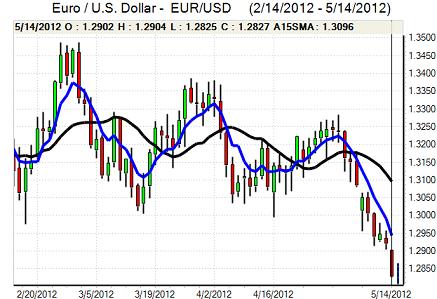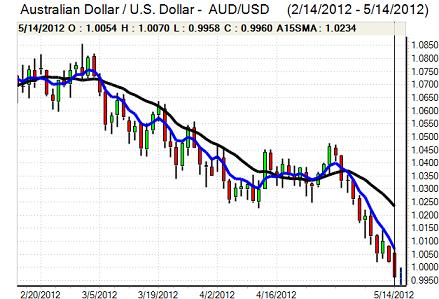EUR/USD
The Euro remained under pressure during the European session on Monday and retreated to fresh four-month lows below 1.2825 before finding some degree of support as Greek and wider euro-zone fears dominated.
Following weekend deadlock in talks between the Greek political parties, there were further fears that political paralysis and opposition to austerity would effectively force Greece out of the Euro-zone. There has been a very important shift in rhetoric surrounding the possibility of a Greek exit with widespread discussion within the media and in diplomatic circles, in contrast to the very tight-lipped attitude a few weeks ago. There were also a series of warnings from Euro-zone officials, notably from Germany, stating that Greece needed to meet the loan conditions in order to receive continued funding.
The Greek president held talks with all the major political parties in an attempt to forge a National Unity government, but SYRIZA still appeared to be resisting attempts to join a government. Political uncertainty had an important impact in undermining risk appetite as markets continued to fear the implications of Greek exit. The Greek President will hold further talks on Tuesday and any move to form a government would provide initial Euro relief.
There were further fears surrounding Spain with major doubts surrounding the banking sector. There was an increase in benchmark Spanish bond yields to above the 6.3% level while the spread over German bunds widened to a record high. Moody’s also announced a credit-rating downgrade of 26 Italian banks which reinforced fears surrounding the European banking sector given the sovereign-debt default risk
There was a sharp decline in equity markets which helped trigger a further exodus of short-term funds out of the Euro with a wider deterioration in risk appetite. The dollar secured defensive support while there were no major US developments during the session. A firmer German GDP first-quarter release provided limited relief for the Euro as it moved back to the 1.2850 area.

Source: VantagePoint Intermarket Analysis Software
Call now and you will be provided with FREE recent forecasts
that are up to 86% accurate* 800-732-5407
If you would rather have the recent forecasts sent to you, please go here
Yen
The dollar stalled in the 80.20 region against the yen on Monday as momentum stalled and the US dipped sharply during the European session with lows close to 79.70.
The US currency was undermined by a further decline in US Treasury yields as the 10-year benchmark yield dipped to 2012 lows below 1.80%.
The yen also gained wider support from a general deterioration in risk appetite during the European session as equity markets fell sharply. Dollar losses were contained by wariness over the possibility of Japanese intervention and both currencies also secured defensive demand which limited relative movements. The dollar nudged higher on Tuesday, but was capped below the 80 level.
Sterling
Safe-haven considerations remained the dominant influence on Sterling during the day as rumours and speculation continued to swirl around the Euro-zone with the threat of a Greek Euro exit. There was evidence of notable capital inflows into Sterling with UK 10-year benchmark yields falling to record lows. Sterling found support close to 1.6050 against the dollar and the UK currency broke through the 0.80 level against the Euro which triggered aggressive stop-loss Euro selling as there was a Sterling peak near 0.7970.
There will still be the risk that a deterioration in wider risk appetite will undermine Sterling, especially with doubts surrounding the banking sector. Sterling is being protected by the fact that the sovereign-debt risk is extremely low, but this is only the case because the currency can weaken given a floating currency and wider doubts surrounding the UK economy could suddenly trigger intense selling pressure.
The Bank of England inflation report will be watched very closely on Wednesday for further evidence of underlying economic trends.
Swiss franc
The dollar maintained a firm tone in Europe on Monday and pushed to a high above 0.9350 before losing some momentum. The Euro remained under selling pressure during the day with a test of support below the 1.2010 level.
There was a 2.3% decline in producer prices in the year to April, maintaining underlying concerns surrounding the deflation risks. National Bank Chairman Jordan stated that the franc remained overvalued and there was a further commitment to keeping the minimum 1.20 Euro level in place with a strong suspicion that the central bank was again intervening.

Source: VantagePoint Intermarket Analysis Software
Call now and you will be provided with FREE recent forecasts
that are up to 86% accurate* 800-732-5407
If you would rather have the recent forecasts sent to you, please go here
Australian dollar
The Australian dollar remained under pressure on Monday with fresh 2012 lows close to 0.9950 against the US currency. An underlying deterioration in risk appetite was important in undermining the Australian dollar as Wall Street has retreated for eight of the last nine sessions. There was also a decline in commodity prices which had an important negative impact on sentiment.
The Reserve Bank minutes were broadly in line with expectations with the bank not offering any significant hints on future policy plans. The Australian dollar edged back towards the parity level later in Asian trading on Tuesday.



